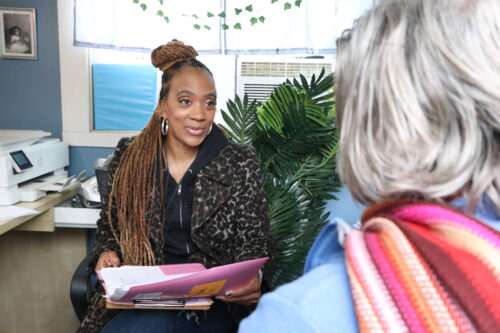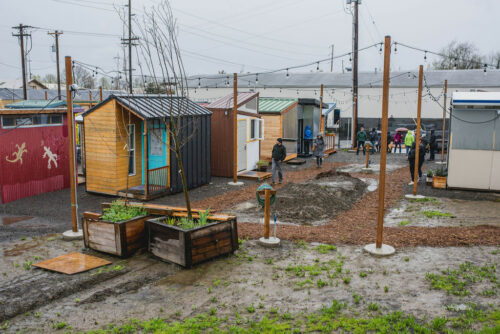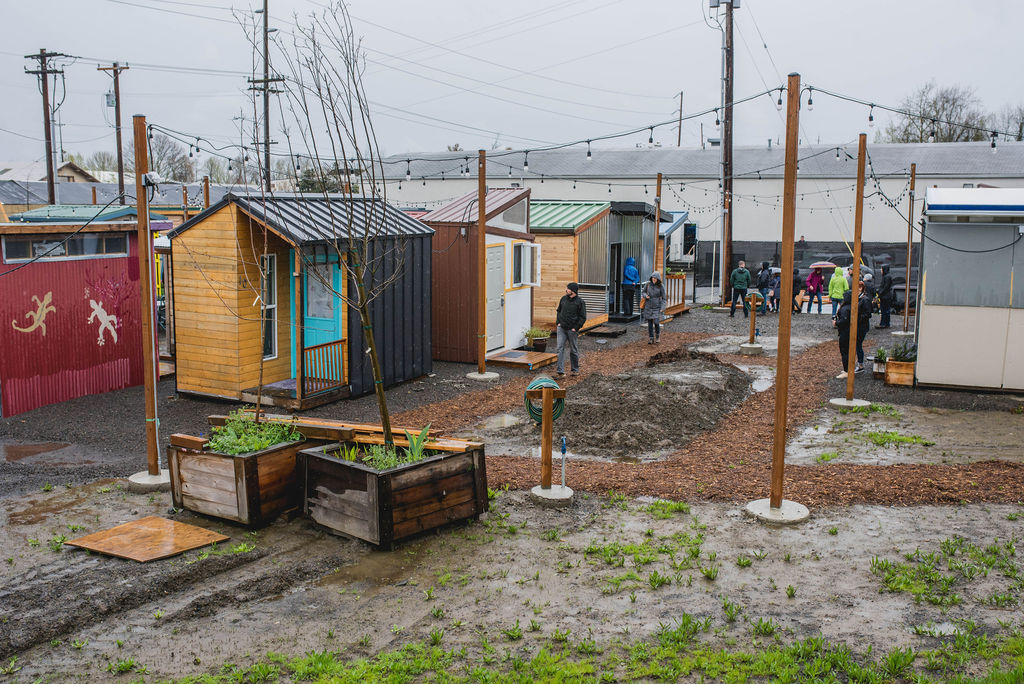Catholic Charities’ Kenton Women’s Village even more successful than average
Formerly homeless people living in pod groupings like Kenton Women’s Village move into permanent housing at three times the rate of those living in more traditional homeless shelters, researchers from Portland State University have found.
A two-year PSU study revealed that 12% of conventional shelter dwellers – who sleep together in large rooms — had moved on to permanent housing. But an average of 36% of those who live in tiny home communities had made the same progress. At Catholic Charities’ Kenton Women’s Village, the success rate is even higher. About 50% of Kenton clients enter permanent housing each year and a year later, 84% are still there.
That fulfillment is due to the close case management over a longer period plus supportive community at the village, says Rose Bak, chief program officer for Catholic Charities of Oregon.
“We find that personal attention and deep respect are what work best when accompanying people who are recovering from trauma,” says Bak.
Having residents stay for six months or a year is a big help compared to congregate shelters, where people stay more briefly, the PSU study explained.

Valerie Peterson, program coordinator at Kenton Women’s Village, speaks with a resident.
In recent video interviews with Catholic Charities, two former Kenton Women’s Village residents and one current resident explained that the village provides a safe zone to heal, reset and move forward when ready.
“They know they feel safe,” says Valerie Peterson, program coordinator at Kenton Women’s Village.” They have expressed a sense of security being here specifically.”
“Before Kenton Women’s Village, life was tough and it was scary,” says Rosemarie, who became homeless after injuring her back but who now lives in a Portland apartment. “Every day I am grateful for that village. Even though it’s my past, I wouldn’t be here without that. Catholic Charities was the lifeline I needed and there at the time I needed it.”
Sarah, a survivor of domestic violence, has lived at the village for less than a year, has a job and is saving money.
“I think I am most grateful for the time that I’ve been able to get myself back together to being like a member of society again,” Sarah says. “I have come a long way. The counseling and the trauma counseling — It’s not something that I probably would have been able to do all on my own. … It’s helped out a lot fot me to get where I am now.
Lunette, now in an apartment, has compassion for people camped on the sidewalks near her. She makes sure they get what they need but also is a model to some of them about what’s possible.
“I am most grateful for the opportunity to reimagine my life,” Lunette says of Kenton Women’s Village.

Kenton Women’s Village
The villages have other advantages, the PSU researchers found. They are among the cheapest housing to set up — if the land on which they stand is provided for free. However, cost of maintaining villages is higher than at traditional congregate shelters.
Jacen Greene, a member of the Portland State research team, told Oregonian reporter Nicole Hayden that the villages seem to have more staff dedicated to case management and housing placement.
Villages also allow for some communal decisions, which researchers linked to resident wellness.
“Giving villagers a voice and sense of agency over how villages operate had a huge impact on villager satisfaction,” said Todd Ferry, who has been working in this field since 2016 as associate director at the PSU Center for Public Interest Design. “It didn’t have to be a full self-governance model. But just a clear way that they were involved in decisions.”
Katricia Stewart worked on the report while pursuing a Ph.D. in community psychology.
“Solutions to homelessness should be safe and support the dignity and humanity of people experiencing homelessness,” Stewart says. “Village models are one way to do those things.”
Key findings in the PSU study:
- 86% of villagers were largely or very satisfied with their pods, 69% were satisfied or very satisfied with their villages, 79% were satisfied or very satisfied with their neighborhoods.
- 45% of villagers report food insecurity. Food insecurity remains a major problem.
- Villages have disproportionately served white men: 17% of villagers in this study identify as BIPOC despite BIPOC residents representing 40% of the unsheltered population in Portland.
- Most neighbors who reported concerns about villages at first reported no longer having those concerns after living near a village.
- 69% of villagers said that they should share in decision-making at the village, while 26% said that only villagers should determine what happens in the village. Overall, the feeling of having a voice in the village had major impacts on villager satisfaction.
Read the PSU study here:
